A Study of Owls
Field Notes XXXI: Photos of owls and photographic insight for capturing images of them.
I stared intently at the wood line, trying to memorize the bushes and leaves where I last saw the owl run into the forest. Pulling the car over into the grass drew my eyes away. Then I grabbed my camera. The telephoto 55-300mm lens was already mounted and settings were adjusted to capturing images at higher speeds. Slowly, deliberately, I stepped in amongst the trees.
Welcome to Field Notes!
Sometimes I photograph animals. The majority of times these are chance, unplanned encounters. In my area of the world there just isn’t enough animal activity to be able to go to an area with a good expectation of seeing something. However, I am always excited at every opportunity.
Today we will look at owls. I’ll tell you about my approach and camera settings and give you a quick story about a sighting that resulted in great photos. We’ll also take a look at some photos that did not turn out ideally.
But first, don’t forget that I have a 2024 calendar available for purchase. No owls in the calendar, just landscapes, but still worth a look. Check it out here-

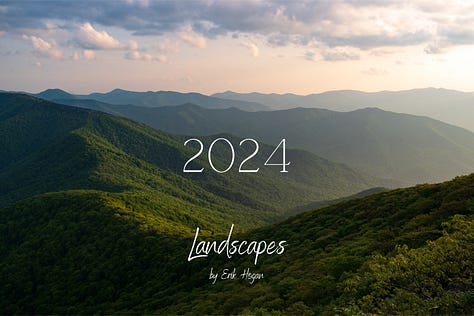

Now, lets go!
I drove very slowly along the quiet neighborhood street in the early morning. The road was so small it did not have lanes. The houses here were spaced far apart on large wooded lots and no one was out. On the left side the road bordered a natural area enveloping Sandy Creek.
Some commotion on the ground ahead caught my eye. I drew close before I could see that it was an owl, standing on the ground by the road. Next to it was its mortal enemy, a crow. The crow cawed, pecked, and flapped at the owl until, dissuaded by my approach, it took to the sky.
The owl remained on the ground. I did not see any obvious injuries, but it seemed incapable of flying away. Instead, it hopped and skipped across the roadway and hurdled into the forest. I reached for my camera as I saw the owl, but this encounter evolved too quickly.
Slow is smooth. Smooth is fast. I parked, got out, and carefully moved to where I had last seen it. Nothing. Only a few moments had passed, but as I looked beyond the facade of foliage into the more open woods beyond I saw only trees. The owl had vanished like a ghost.
Carefully and quietly I continued walking. If it could not fly, the owl could not have gotten very far. Then I found it. About 15 yards from where I stood was a hole in the ground. The hole was where a sizable pine tree once stood. The pine was gone and its stump rotted out, leaving only negative space outlined by the memory of a tree. From this hole, eyes stared at me.
I inched forward as he remained in his bunker, but kept in mind that this owl was under high stress. I did not want to cause him any more. I captured one more image of him and let him be. Out of curiosity, I returned the next day. There was no sign of him.
Georgia is home to primarily 3 different owls. These are the Great Horned Owl, Eastern Screech-owl, and Barred Owl. Both the Great Horned and the Screech Owls have feather tufts on the top of their heads that look like small horns. The owl photographed above is a Barred Owl.
While the Screech Owl and Great Horned Owls are nocturnal, according to Audubon the Barred Owl hunts both night and day, though primarily early morning or late evening. Audubon also explains that an owl’s feathers have unique textures and serrations that distributes airflow around their wings to give them silent flight.
Needless to say, I have encountered owls in the wild on several occasions, but they are a very rare sighting.
Some days I go out into the world without any expectation of photographing a specific landscape, weather condition, or sunrise or sunset. In these cases, I prepare my camera for a chance wildlife encounter. My logic is that for these, the camera needs to be ready to go at a moment’s notice. If I find a nice landscape to photograph instead, I generally have time to change lenses and settings.
For wildlife I use a 55-300mm telephoto lens. I set the camera to shutter speed priority, meaning I choose this value and the camera determines aperture and ISO. I hope to freeze animals in motion and to do this the shutter speed has to be very quick. Finally, I set the shutter release to take multiple captures for as long as I hold down the button. This is ability is obviously beneficial for shooting action, but it also turns on the camera’s internal stabilization for hand held shooting.
One setback I have for this type of photography is auto focus. I use a Pentax K70, which I knew had limited auto focus tracking capabilities. I chose the camera for other reasons, and this I something I just have to do my best to work around.
By the sound of it, this technology should make photographing animals easy. However, nature always seems to throw challenges in the way. In June of this year a friend of mine found another Barred Owl in a tree near a local park. I came to take a look and the bird was quite content to sit on a branch in the shade of a large sycamore tree. The shade immediately became a problem.
I took these photos at 300mm, handheld. Even with the owl still, to accomplish this handheld without blurring the image I needed a shutter speed of at least 1/300 sec, if not quicker. To make this happen, the camera widened the aperture as much as possible, but then was forced to increase the ISO very high.
For those of you unfamiliar, the ISO is the sensitivity of the sensor in the camera. Increasing it allows the camera to capture more information in lower light settings. The problem with this is that it quickly introduces noise. Noise is the grain you see so often in low light cell phone photos.
In this case, with the lighter sky in the background, the owl was still in very dark shadows. I was able to recover a lot of the shadow detail in post processing, but this brought in a large amount of noise. Adobe Lightroom has noise reduction tools, which dampened it tremendously. However, this becomes a balancing game, as the noise reduction erases detail.
While shooting this owl I discovered that there was a second one nearby. It was in slightly brighter shade, but a bit further away. Here are the images I took-
Well, this is all I have for this week, or until I run across another owl. I hope you’ve enjoyed it!
Remember, you can support Field Notes by sharing it, forwarding the emails, or just telling your friends. I’m thrilled that the list of subscribers is growing and spreading the word helps a lot!
And if you haven’t yet, please consider subscribing for yourself. Field Notes is free and comes out every Sunday. Signing up means you won’t miss it!
Hey, if you made it this far to the bottom of the post, I have a question for you. Substack just upgraded their video sharing capabilities. I’ve made short films of some of my backpacking trips with my GoPro and shared the YouTube link here in past issues. Would you be interested in occasional video posts? They take a lot of effort to edit, so would likely take the place of a week’s writing and photography. I’m considering exploring it more, but would like to hear your interest level in the comments! Thanks!
-Erik








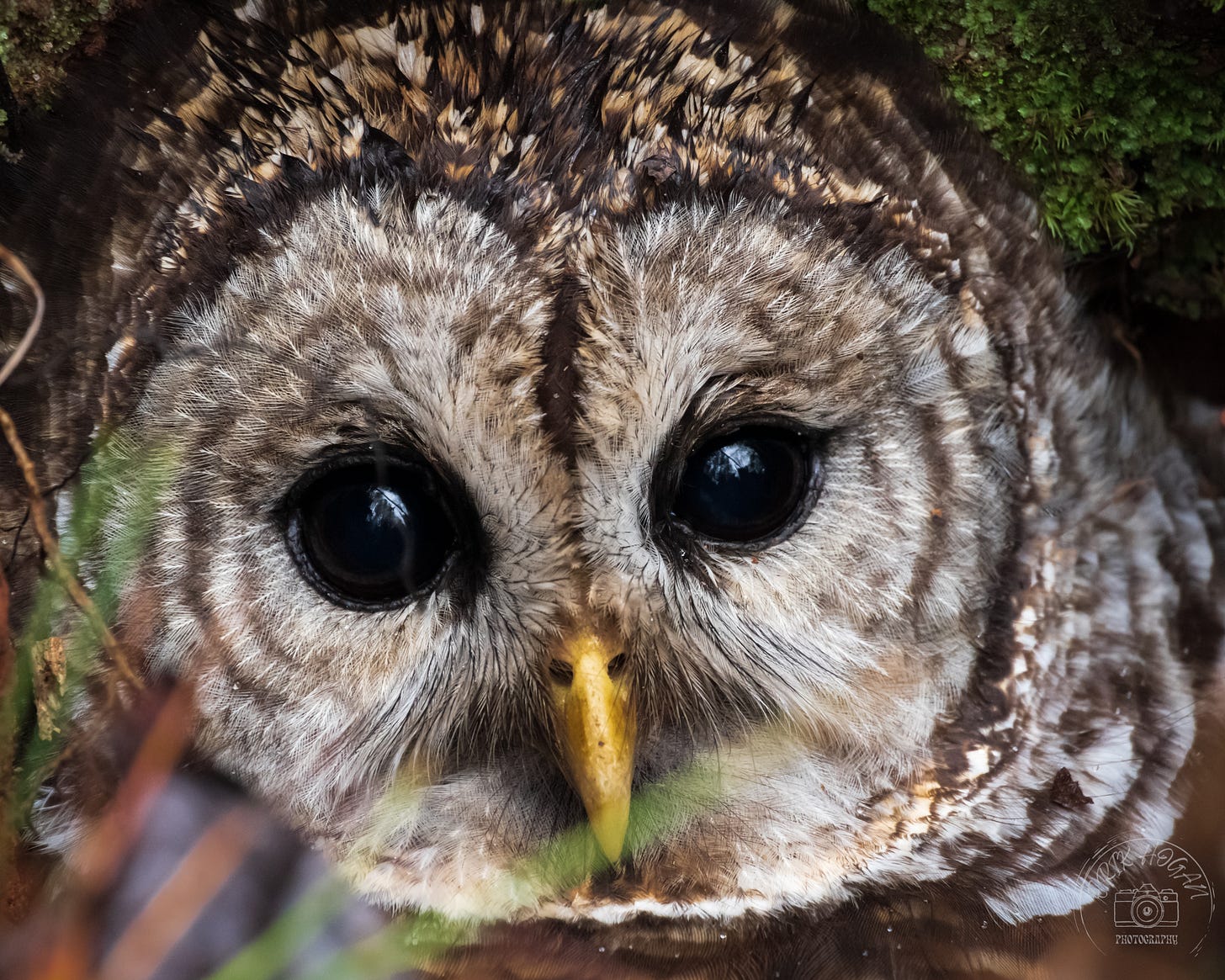



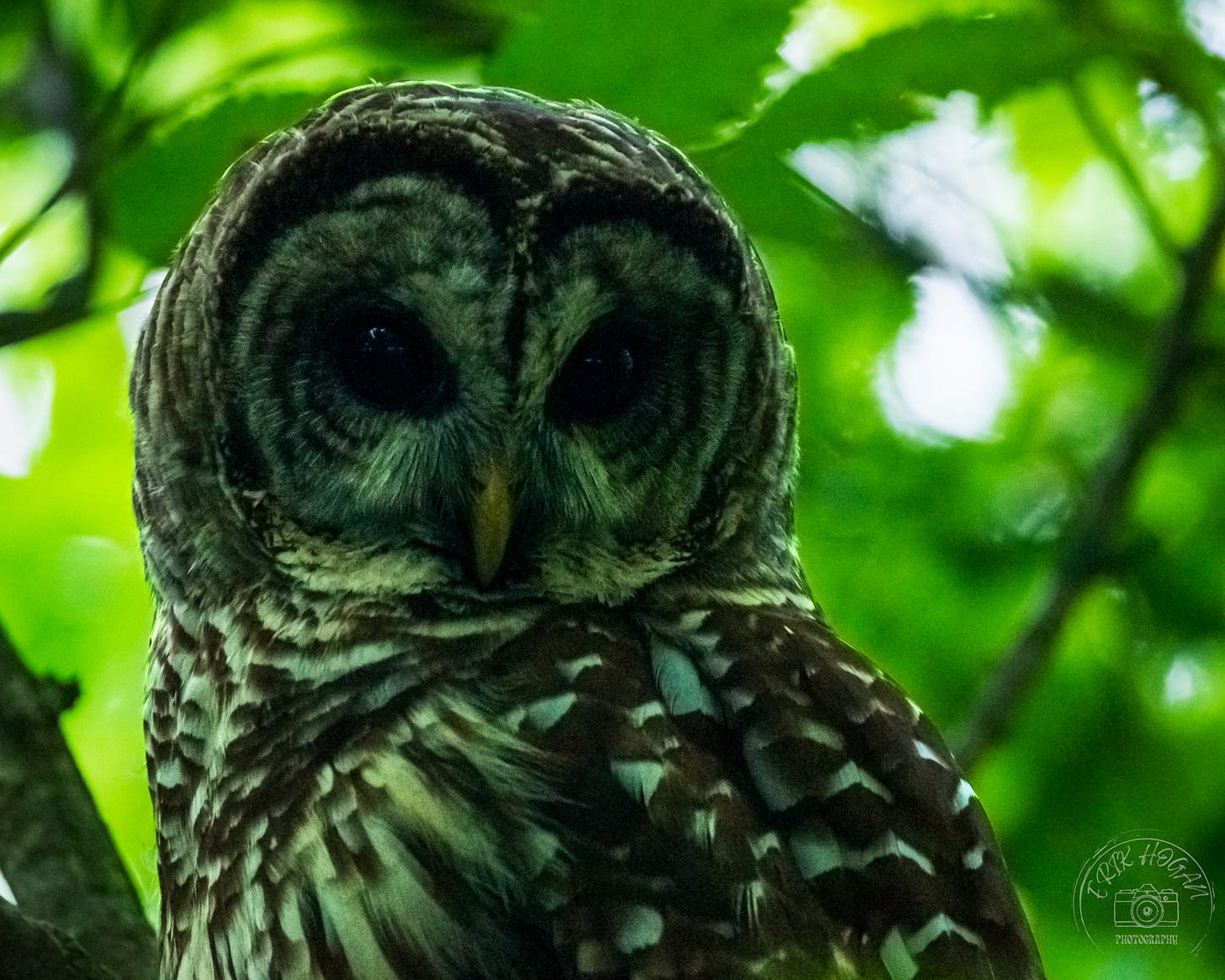
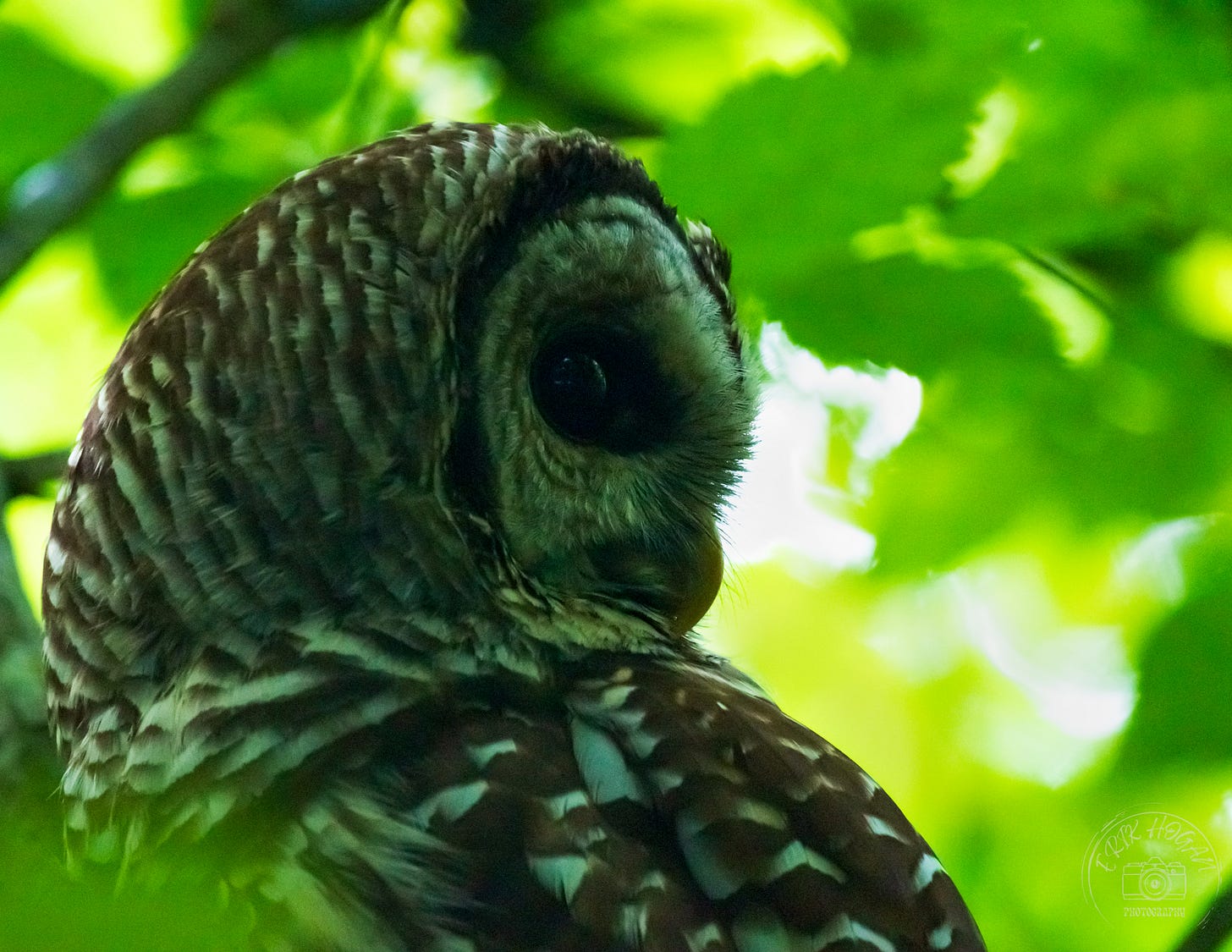


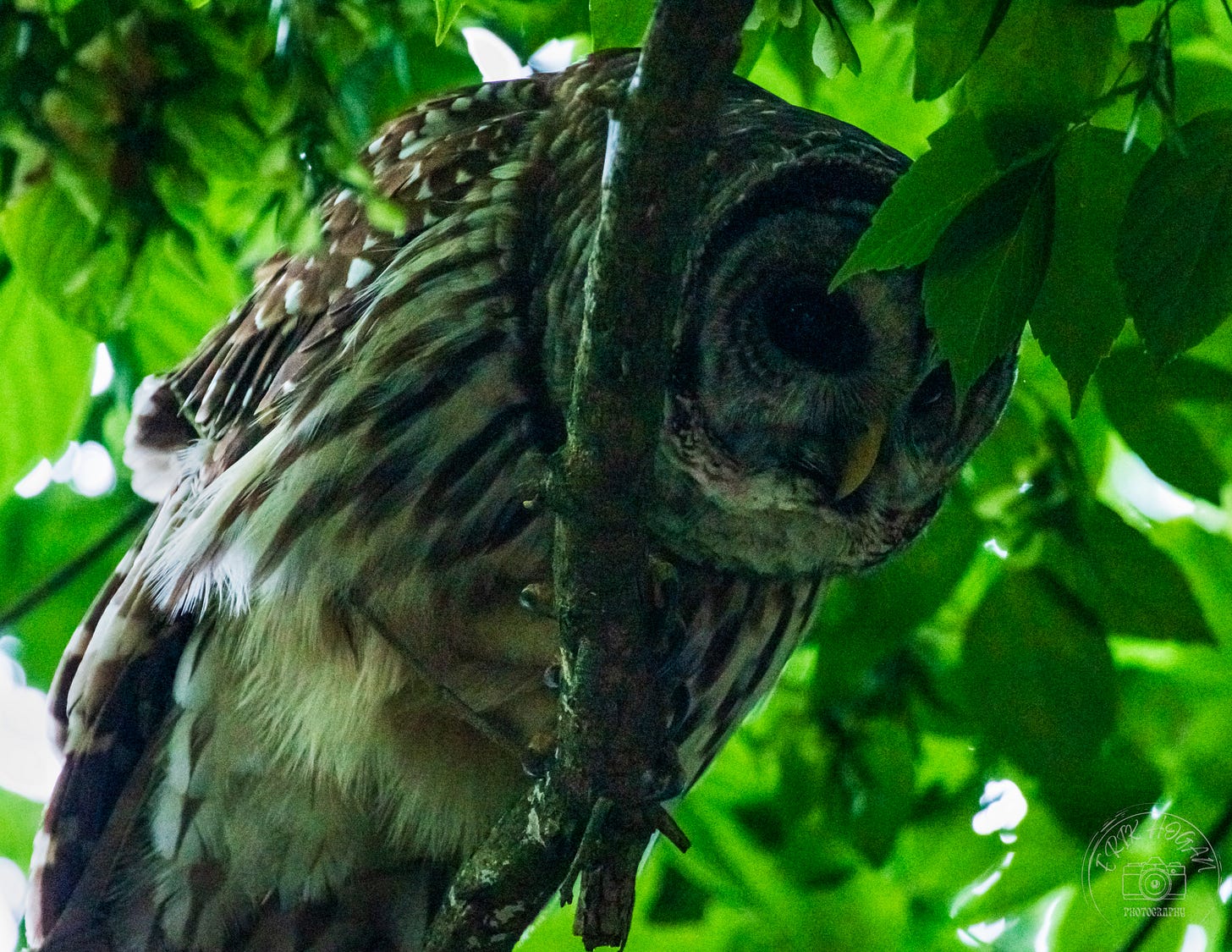


Amazing pics! Over the summer I was ascending one section of Mt. Rainier on a long day hike, about 10 miles long and 1000 m of elevation—on one steep section where no one else was around, we saw a huge marmot nearby that suddenly stood up on its legs—quickly followed by what I thought might be a drone swishing over our heads very quickly, very close, as the marmot dove for cover—it was an intense sound and kind of scary—I realized it was probably an eagle hunting.
Great overview Erik and excellent detail in those pics. I like the one with just his eyes poking out though he does seem a little spooked.
Photographing owls is often on my mind, but I never see them in daylight hours. I hear them at night around my house, but rarely catch anything other than a swift fly by.
I don't think we have barred owls here though, so maybe most our locals are the nocturnal variety. In fact, I think last time I photographed an owl out in nature was in Georgia, and that was a while ago now.